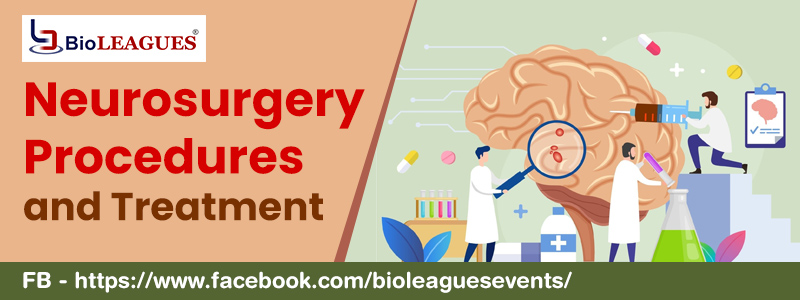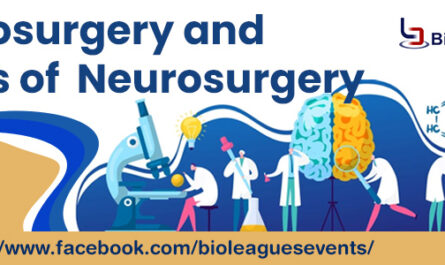Neurosurgery Procedures
Neurosurgical procedures can be performed on both pediatric and adult patients. When it comes to these procedures themselves, there are a number of surgical and non-surgical options. Each of these options is performed depending on the nature of the disorder, disease, or type of injury. Modern invasive and non-invasive surgical procedures have greatly simplified brain surgeries. Detailed below are some of the most common types of neurosurgery procedures performed by a Neurosurgeon. To know more in detail about every one of these procedures, however, it is best that you register yourself for any one of the upcoming Neuroscience Conferences.
- Anterior Cervical Discectomy
Almost everyone can experience some kind of neck pain at some point in their life. If a herniated disc is the cause of the neck pain, then a neurosurgeon is the solution to the problem. The radiating pain due to a herniated disc can be almost unbearable. These disc problems can be resolved with surgery in most cases. This is a common procedure to remove the damaged disc.
- Craniotomy
It is unfortunate that thousands of people fall victim to stroke or head trauma annually. Luckily, there are expert neurologists to perform neurosurgical procedures for these victims to help save their lives. This is one of the procedures where part of a patient’s skull creates additional space for the brain to avoid the threat of brain crushing. The forthcoming Neuroscience Congress will enlighten participants about the intricacies of craniotomy.
- Chiari Decompression
It is a procedure made for people who have a defect in the brain that controls balance. This condition is also called Arnold-Chiari malformation. Chiari Decompression is the safest neurosurgical procedure for treating this condition, in which a bone in the back of the patient’s skull is removed so that the patient has improved balance and coordination.
- Laminectomy
This is normally a minimally invasive procedure where small incisions are made in the skin during surgery in order to discard a small portion of the blade or spinal bone. This is a common procedure for patients with severe back pain.
- Lumbar Puncture
This is often a simple but very efficient procedure. Lumbar Puncture is also known as a lumbar puncture and is used to diagnose the number of underlying diseases affecting a patient’s central nervous system. Participants of this upcoming neurology conference will receive in-depth insights into the lumbar puncture.
- Epilepsy Surgery
Usually, the first basic treatment for people with epilepsy is medication. If the drugs are not effective, the neurological specialist opts for surgical treatment as the next option. Most procedures involve the removal of a small part of the brain that’s responsible for giving rise to seizures that can prove to be fatal.
- Spinal Fusion
Spinal fusions are used to treat degenerative diseases or traumatic injuries of the spine. The spinal fusion surgical procedure is performed to keep the patient’s spine in a steady and secure position. Attend any of the Neuroscience Meetings set to take place to learn more about spinal fusion and its advantages.
- Micro discectomy
This neurosurgical procedure is employed to treat those with painful herniated discs in the lumbar region.
- Ventriculostomy
As part of this procedure, doctors will use a tube to remove excess fluid from a patient’s brain. This is a procedure performed without implantation.
- Ventriculoperitoneal Shunt
It is also a procedure used to remove fluid that accumulates in a person’s brain. In this case, a shunt is implanted in the brain to drain the excess fluid that has accumulated in the head. Want to learn more about Ventriculoperitoneal shunt? Register yourself for any one of the forthcoming Neurology Conferences. When the brain isn’t functioning as it should, the body will become static. If the brain is not functioning normally, the body starts to go into a vegetative state – neurosurgery then comes into play. The use of modern surgical procedures that are both invasive and non-invasive has streamlined many brain surgeries as well as other intricate procedures and saved many lives.
Neurosurgery Treatment
- Cyber Knife
Even though it might seem like a type of surgery, CyberKnife is in fact a pain-free, non-invasive method of radiation that produces accurate and powerful therapy for cancers all across the body, even in areas earlier thought unattainable. This technique involves a combination of computers, image-guided cameras, and robotic technology to focus radiation directly on tumor cells while limiting radiation exposure to surrounding healthy tissue.
- Deep Brain Stimulation (DBS)
This treatment option is based on the very same technology used in pacemakers – delivering carefully controlled electrical pulses to accurately targeted localities of the brain that influence movement. The electrical charge interrupts or cancels faulty brain signals and, in conjunction with medication, reduces stiffness, trembling, feebleness in movement, and other symptoms of radical movement disorders.
- Gamma Knife
Gamma Knife is the most precise tool for treating brain tumors and other neurological diseases sans open brain surgery. A minimally invasive alternative to conventional grain surgery, this technique allows for safe and effective treatment, usually with fewer side effects. As a result, it is an outpatient treatment. Register and take part in this Neurology Congress to get well-versed with the Gamma Knife procedure.
- Minimally Invasive Spine Surgery
When it comes to minimally invasive procedures, surgeons make a miniature incision and utilize superior computer tech and techno-scientific tools to correct ailments of the posterior and spine. In microscopic surgery, surgeons combine minimally invasive techniques with state-of-the-art, highly sensitive surgical microscopes to accurately access the most delicate areas.
- Nervous Decompression
This treatment option is a minimally invasive surgical procedure to relieve pressure caused by a neuroma, pinched or trapped nerve. The surgeon alleviates the pressure on the nerve by cutting narrow tunnels surrounding it. By doing this, although the nerve might still be swollen, there is no pressure being put on it by surrounding structures in your body, allowing the nerve to start functioning normally again.
- Nerve Reconstruction Surgery
To preserve function in cases where nerve damage has taken place, surgeons make use of microsurgical suturing techniques. Albeit, surgeons are usually not able to reconnect the nerve fibers due to the degree of damage at the site of injury. Alternatively, surgeons use a combination of techniques to repair nerves.




